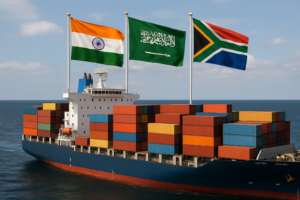National Fleets: Saudi Arabia, India, and South Africa signal shift in global trade

In a world where maritime routes are increasingly contested and supply chain resilience has become a matter of national security, Saudi Arabia, India, and South Africa are each preparing to reclaim or assert their roles as shipping powers.
These three nations, positioned strategically across the Red Sea, Indian Ocean, and the southern tip of Africa, are laying the groundwork for new national commercial fleets.
Their ambitions reflect more than economic pragmatism; they signal a reshuffling of maritime geopolitics in response to a changing global order.
More than 25 years after the sale of Safmarine to Maersk, South Africa is finally moving to reestablish a national shipping line.
The proposed South African Shipping Company is expected to serve national and regional interests with a fleet that may include container ships, tankers, dry bulk vessels, and bunker barges, whether new or secondhand. All will be flagged in South Africa, underscoring Pretoria’s intent to strengthen maritime sovereignty.
This comes at a time when control over logistics chains has become central to national resilience, especially in light of recent disruptions in the Red Sea and along the Cape of Good Hope.
For Saudi Arabia, maritime expansion is not just about logistics but a cornerstone of Vision 2030, its long-term strategy to diversify the economy away from oil.
Folk Maritime, a new shipping line backed by the Public Investment Fund, is actively acquiring ships to dominate feeder services in the Red Sea and Gulf region. The company’s acquisition of vessels like the Folk Jazan positions it to capture up to 45% of Red Sea and 35% of Gulf feeder trade by 2030, according to government projections.
Saudi Arabia’s geographic location at the tri-continental crossroads of Asia, Europe, and Africa gives it a pivotal role in global trade.
Folk Maritime’s development reflects Riyadh’s strategic intent to anchor its future as a global logistics hub. Moreover, its expanding maritime capabilities provide additional leverage amid heightened regional tensions and evolving global trade patterns, such as shifting cargo away from the Suez Canal due to security risks.
On the other hand, India, under Prime Minister Narendra Modi, has launched an ambitious initiative to establish a 1,000-ship national fleet within a decade.
With major state-owned enterprises, including those in oil, gas, and fertilizer, teaming up with the Shipping Corporation of India and potentially foreign partners, the proposed company is meant to reinforce India’s maritime sovereignty and tap into growing trade volumes.
This fleet expansion aligns with India’s strategic aim of becoming a developed economy by 2047 and builds on its Sagarmala infrastructure project, which seeks to modernize port logistics and improve coastal shipping.
It also mirrors India’s aspiration to act as a counterbalance to China’s dominance in regional shipping, offering alternative logistical pathways for Indo-Pacific trade.
These moves reflect a broader geopolitical recalibration as the Red Sea crisis, climate-related threats to chokepoints, and rising piracy and asymmetric threats in regions like the Gulf of Guinea and Persian Gulf have only reinforced the need for national or regionally controlled fleets.
With increased trade between the Middle East, Africa, and South Asia, these new fleets are poised to capitalize on South-South trade flows that bypass traditional Atlantic-centric routes.
![]()
The post National Fleets: Saudi Arabia, India, and South Africa signal shift in global trade appeared first on Container News.
Content Original Link:
" target="_blank">

































































